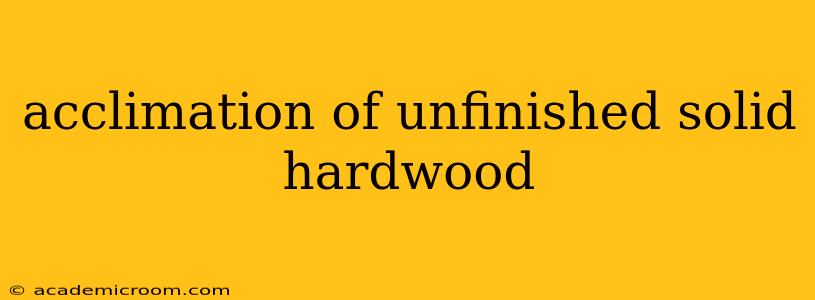Choosing unfinished solid hardwood flooring offers unparalleled customization and longevity. However, before you even think about nailing down those beautiful planks, you must understand the crucial process of acclimation. Failure to properly acclimate your wood can lead to significant problems down the line, including warping, cupping, shrinking, and gapping—rendering your beautiful floor a costly disaster. This comprehensive guide will walk you through everything you need to know about acclimating unfinished solid hardwood.
What is Acclimation?
Acclimation is the process of allowing your unfinished solid hardwood flooring to adjust to the temperature and humidity levels of your home. Wood is a hygroscopic material, meaning it absorbs and releases moisture based on its environment. When wood with a different moisture content is installed in a home with a different environment, it will attempt to equalize, resulting in the aforementioned problems. Proper acclimation ensures the wood's moisture content stabilizes before installation, minimizing the risk of future issues.
How Long Does Acclimation Take?
The acclimation period for unfinished solid hardwood flooring typically ranges from 7 to 10 days, but it can take longer depending on several factors:
- Wood species: Different wood species have varying densities and moisture absorption rates. Some species may require a longer acclimation period.
- Climate: Extremely dry or humid climates may require a longer acclimation time. Rapid changes in temperature and humidity will also extend the process.
- Packaging: How the wood is packaged influences acclimation. Properly sealed and stacked wood may acclimate faster.
- Home environment: The consistency of temperature and humidity in your home is critical. Consistent conditions lead to faster and more reliable acclimation.
Where Should I Acclimate My Hardwood?
The ideal location for acclimation is the room where the flooring will be installed. This ensures the wood adjusts to the precise conditions of its final location. If this is impossible, choose a similar area within your home that has:
- Consistent temperature: Avoid areas subject to extreme temperature fluctuations (e.g., near fireplaces, HVAC vents).
- Consistent humidity: Maintain a stable humidity level within the recommended range (30-50% relative humidity is ideal). Use a hygrometer to monitor humidity levels.
- Proper ventilation: Ensure adequate air circulation around the wood stacks.
- Flat surface: Stack the wood on a flat, dry surface to prevent warping.
How Should I Stack My Hardwood?
Proper stacking is essential for even acclimation. Follow these steps:
- Remove the wood from its packaging: Allow the wood to breathe.
- Stack horizontally: Create stacks of planks, keeping them flat and level.
- Space the stacks: Leave adequate space between stacks for air circulation.
- Cover (optional): Some professionals recommend covering the stacks with a breathable material like a canvas drop cloth, particularly in particularly dry or dusty environments. However, ensure good air circulation.
What if I Don't Have Enough Time to Acclimate?
While attempting to rush the acclimation process is strongly discouraged, if you're facing a tight deadline, consider these options:
- Consult a professional: An experienced flooring installer can advise you on the feasibility of faster acclimation based on the specific circumstances.
- Use climate control: If possible, use a dehumidifier or humidifier to stabilize the environment more quickly. However, it is crucial to do this gradually to prevent shock to the wood.
What are the signs of improper acclimation?
After installation, signs of improper acclimation might include:
- Cupping: The edges of the planks curl upwards.
- Crowning: The center of the plank rises.
- Gapping: Spaces appear between the planks.
- Warping: The planks become uneven or distorted.
Addressing these problems after installation is significantly more challenging and costly than proper acclimation beforehand.
What is the ideal humidity level for hardwood flooring?
Maintaining the proper humidity level in your home is crucial not only for acclimation but also for the long-term health of your hardwood floor. Ideally, keep your home's relative humidity between 30% and 50%. Using a hygrometer will allow you to monitor the humidity levels and use a humidifier or dehumidifier to adjust accordingly.
Can I acclimate unfinished solid hardwood in the winter?
Acclimating unfinished solid hardwood in the winter can be more challenging due to lower humidity levels caused by heating systems. You'll need to pay extra attention to humidity control and may need to run a humidifier to maintain optimal conditions. Using a hygrometer to monitor and adjust will be essential.
By following these guidelines, you can ensure your unfinished solid hardwood flooring is properly acclimated, setting the stage for a beautiful and long-lasting floor. Remember, patience and attention to detail are key to this crucial step in the hardwood installation process.
